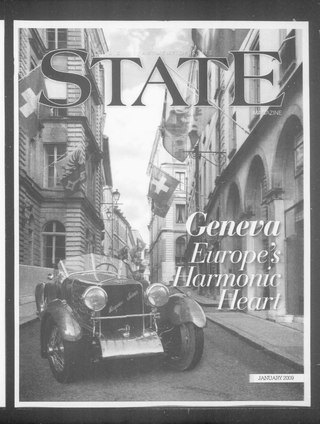
A magazine is a periodical publication, generally published on a regular schedule, containing a variety of content. They are generally financed by advertising, purchase price, prepaid subscriptions, or by a combination of the three.

A British comic is a periodical published in the United Kingdom that contains comic strips. It is generally referred to as a comic or a comic magazine, and historically as a comic paper.
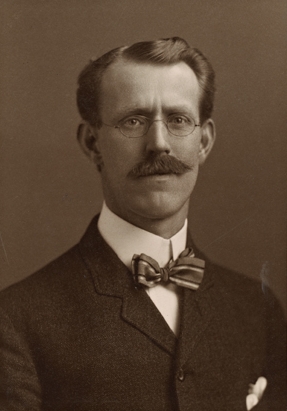
Edward L. Stratemeyer was an American publisher, writer of children's fiction, and founder of the Stratemeyer Syndicate. He was one of the most prolific writers in the world, producing in excess of 1,300 books himself, selling in excess of 500 million copies. He also created many well-known fictional book series for juveniles, including The Rover Boys, The Bobbsey Twins, Tom Swift, The Hardy Boys, and Nancy Drew series, many of which sold millions of copies and remain in publication. On Stratemeyer's legacy, Fortune wrote: "As oil had its Rockefeller, literature had its Stratemeyer."
Young adult literature (YA) is literature, most often including novels, written for readers from 12 to 18 years of age. The term YA was first used regularly in the 1960s in the United States. The YA category includes most of the genres found in adult fiction, with themes that include friendship, sexuality, drugs and alcohol, and sexual and gender identity. Stories that focus on the challenges of youth may be categorized as problem novels or coming-of-age novels. The boundary between children's and adult literature is flexible, subject to moral and political ideology, and in some cases meaningless.

John Kendrick Bangs was an American writer, humorist, editor and satirist.
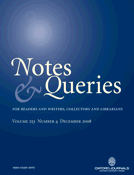
Notes and Queries, also styled Notes & Queries, is a long-running quarterly scholarly journal that publishes short articles related to "English language and literature, lexicography, history, and scholarly antiquarianism". Its emphasis is on "the factual rather than the speculative". The journal has a long history, having been established in 1849 in London; it is now published by Oxford University Press.
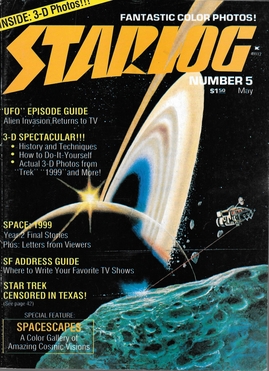
Starlog was a monthly science fiction magazine that was created in 1976 and focused primarily on Star Trek at its inception. Kerry O'Quinn and Norman Jacobs were its creators and it was published by Starlog Group, Inc. in August 1976. Starlog was one of the first publications to report on the development of the first Star Wars movie, and it followed the development of what was to eventually become Star Trek: The Motion Picture (1979).

St. Nicholas Magazine was a popular monthly American children's magazine, founded by Scribner's in 1873. The first editor was Mary Mapes Dodge, who continued her association with the magazine until her death in 1905. Dodge published work by the country's leading writers, including Louisa May Alcott, Frances Hodgson Burnett, Mark Twain, Laura E. Richards and Joel Chandler Harris. Many famous writers were first published in St. Nicholas League, a department that offered awards and cash prizes to the best work submitted by its juvenile readers. Edna St. Vincent Millay, F. Scott Fitzgerald, E. B. White, and Stephen Vincent Benét were all St. Nicholas League winners.

The London Magazine is the title of six different publications that have appeared in succession since 1732. All six have focused on the arts, literature and miscellaneous topics.

The Sleeper Awakes is a dystopian science fiction novel by English writer H. G. Wells, about a man who sleeps for two hundred and three years, waking up in a completely transformed London in which he has become the richest man in the world. The main character awakes to see his dreams realised, and the future revealed to him in all its horrors and malformities.

The Boy's Own Paper was a British story paper aimed at young and teenage boys, published from 1879 to 1967.

George Manville Fenn was a prolific English novelist, journalist, editor and educationalist. Many of his novels were written with young adults in mind. His final book was his biography of a fellow writer for juveniles, George Alfred Henty.
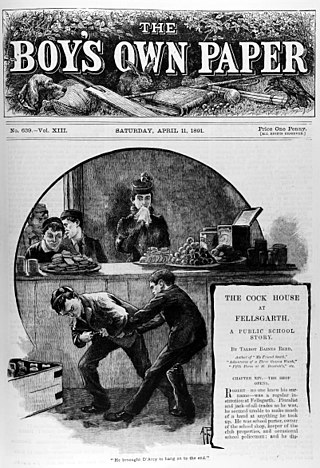
Magazines intended for boys fall into one of three classifications. These are comics which tell the story by means of strip cartoons; story papers which have several short stories; and pulp magazines which have a single, but complete, novella in them. The latter were not for the younger child and were often detective or western in content and were generally greater in cost. Several titles were published monthly whereas the other two categories were more frequent.

Elbridge Streeter Brooks was an American author, editor, and critic. He is chiefly remembered as an author of numerous works of fiction and nonfiction for children, much of it on historical or patriotic subjects. His byline for most of his writing was Elbridge S. Brooks.
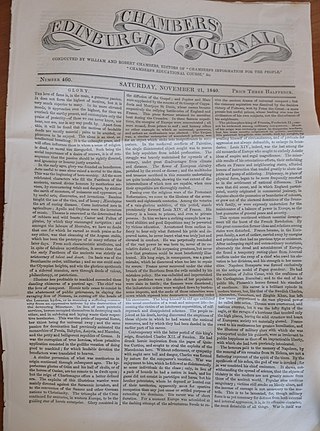
Chambers's Edinburgh Journal was a weekly 16-page magazine started by William Chambers in 1832. The first edition was dated 4 February 1832, and priced at one penny. Topics included history, religion, language, and science. William was soon joined as joint editor by his brother Robert, who wrote many of the articles for the early issues, and within a few years the journal had a circulation of 84,000. From 1847 to 1849, it was edited by William Henry Wills. In 1854 the title was changed to Chambers's Journal of Popular Literature, Science, and Art, and changed again to Chambers's Journal at the end of 1897.

The Hotspur was a British boys' paper published by D. C. Thomson & Co. From 1933 to 1959, it was a boys' story paper; it was relaunched as a comic in October 1959, initially called the New Hotspur, and ceased publication in January 1981.

Shueisha Inc. is a Japanese company headquartered in Chiyoda, Tokyo, Japan. Shueisha is the largest publishing company in Japan. It was established in 1925 as the entertainment-related publishing division of Japanese publisher Shogakukan. The following year, Shueisha became a separate, independent company.
This page list the published work of Harry Collingwood, the pseudonym for William Joseph Cosens Lancaster. The 44 novels and the stories are organised by year of first publication, but the tables can be sorted interactively.
Robert Leighton was a Scottish journalist, editor, and writer of boys' fiction. He was an editor of juvenile magazines, and through his work at Young Folks he met his future wife Marie Connor, a prolific author in her own right. Leighton became an expert on dogs and their care and produced many works on this topic.
Mary Catherine Rowsell was an English novelist, author of children's fiction, and dramatist. Her education in Belgium and Germany resulted in books based on German folk tales, and on French historical figures. Most of her children's books were set around well-known historical events.
















